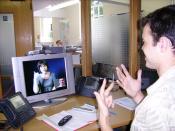Article Link: http://www.eric.ed.gov/ERICDocs/data/ericdocs2/content_storage_01/0000000b/80/2a/2a/78.pdf
This article discusses the education of deaf or hard of hearing children with regard to the Total Communication (TC) approach. The authors, L. Hawkins and J. Brawner, note that TC is not a method of educating deaf or hard of hearing children, but rather a philosophy of communication. TC reflects the use of a blend of oral, manual, auditory, and written means of communication to educate these children, and that the teacher needs to employ one or more of these means based on a child's stage of development. TC permitted a crossover from a simple oral philosophy to one which also uses sign language. TC became popular in the 1970's and 1980's in the education of deaf and hard of hearing children.
The authors note that family members as well as educators can utilize TC. It allows all hearing impaired family members to use speaking and signing as a means to be in continual touch with communication in a specific environment.
Learning takes place by intrapersonal interaction. Such learning can only happen when all parties can communicate with understanding. Therefore, the quality of the relationship between the child and others depends on the quality of communication that exists in that relationship.
TC is exceptionally advantageous because it permits the child to employ the form of communication best suited for him at the moment. TC uses any and all types of communication for deaf children and the mix of modes of communication in TC offers a spectrum of paths for use by everyone involved.
TC does have its limitations. A child may not be ready developmentally for all the combinations of modes of communication. Therefore, teachers may be restricted as to how many means of communication may be used at a given moment.
Finally, the...


